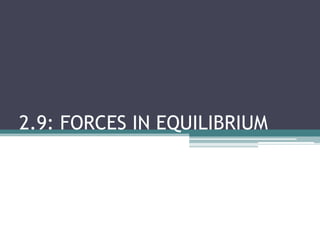F4 ch2.9
- 1. 2.9: FORCES IN EQUILIBRIUM
- 2. Forces in Equilibrium When an object is in equilibrium, the resultant force acting on it is zero. The object will either be 1. at rest 2. move with constant velocity.
- 3. RESULTANT FORCEA single force that represents the combined effect of two of more forces in magnitude and direction.
- 4. Examples( Label the forces acted on the objects)
- 5. Addition of Forces Resultant force, F = ____ + ____ Resultant force, F = ____ + ____
- 7. STEP 1 Using ruler and protractor, draw the two forces F1 and F2 from a point.
- 8. STEP 2 Complete the parallelogram
- 9. STEP 3Draw the diagonal of the parallelogram. The diagonal represent the resultant force, F in magnitude and direction.
- 10. Resolution of Forces A force F can be resolved into components which are perpendicular to each other: (a) horizontal component , FX (b) vertical component, FY
- 11. Resolution of Forces Component of weight parallel to the plane = mg sin Îļ Component of weight normal to the plane = mg cosÎļ Fx= F cosÎļ Fy= F sin Îļ










